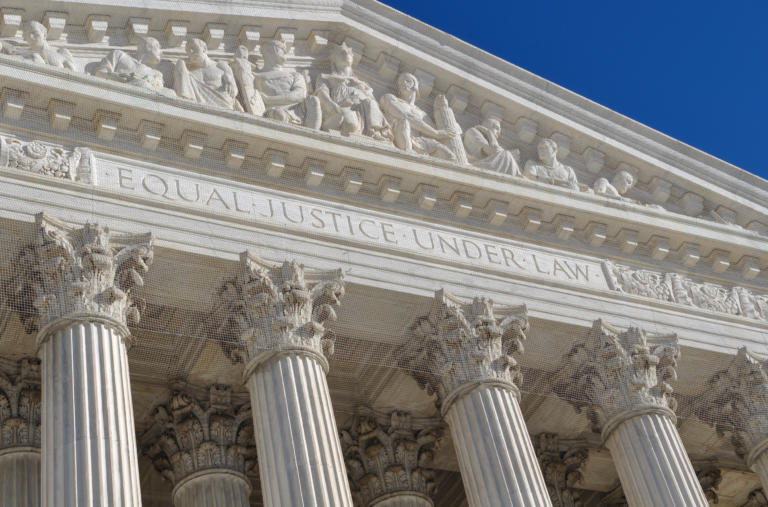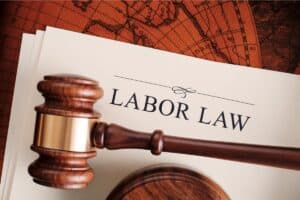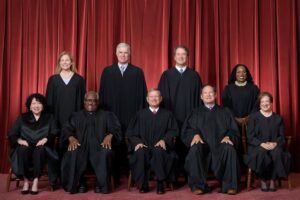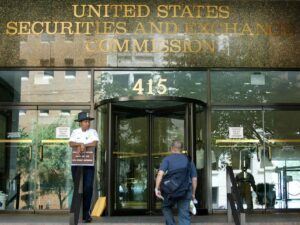Law & Liberty: Jarkesy and Chicken Little Law Professors

Just about every time a case involving the administrative state heads to the Supreme Court, we’re subjected to hysterical warnings of the end of the world. A recent piece in The Atlantic might set a new standard for apocalyptic fearmongering. NYU Law Professor Noah Rosenblum frets that what he calls a garden-variety securities fraud case could “destroy the government.” And that’s just the title! The hyperbole and question-begging continue throughout.
The sky-is-falling case—Securities and Exchange Commission v. Jarkesy—raises many interesting and contentious issues about the Constitution’s separation of powers. And Prof. Rosenblum is plenty contentious. But he gets the big picture wrong. In his zeal to show how dumb and simple and misguided “right-wing activists” are, he ignores the “declared purpose” of the separation of powers—to “diffuse power the better to secure liberty,” a point Justice Kavanaugh made during oral argument. Prof. Rosenblum looks only at what the government can (theoretically) do for us; he ignores what it can (in practice) do to us. Prof. Rosenblum’s screed also ignores the biggest issue in the case.
But first, the background. The SEC accused Mr. Jarkesy of making material misrepresentations in connection with his two hedge funds. These kinds of claims—what Prof. Rosenblum describes as “garden-variety securities fraud”—have traditionally been heard by independent judges and juries. The SEC, however, decided to commence an administrative enforcement action, in which employees of SEC’s enforcement division try the case in front of another SEC employee, an administrative law judge (ALJ). And, as Justice Gorsuch pointed out, in-house agency trials employ “relaxed rules of procedure and evidence—rules [the agencies] make for themselves.”
Predictably, the SEC’s ALJ ruled in favor of the SEC. Mr. Jarkesy’s only option was to appeal—to the SEC itself. And, just as predictably, the SEC concluded that SEC’s enforcement employees successfully proved their case and that the SEC-employed ALJ correctly ruled for the SEC.
Only after this process was complete was Mr. Jarkesy allowed to petition a court of law for review. Mr. Jarkesy challenged both the SEC’s substantive decision and the constitutionality of the SEC’s process. Or, as Prof. Rosenblum would have it, Mr. Jarkesy responded with “chutzpah. He didn’t just contest the SEC’s ruling; he alleged that the SEC’s entire process against him was unconstitutional.”
The nerve of that Jarkesy fellow! Who does he think he is?! How could he possibly object to a process, in which an agency acts as rule-maker, prosecutor, judge, jury, and appellate court?
Imagine a hypothetical, SEC-like proceeding: a US Attorney brings a civil or criminal case before a Department of Justice ALJ without a jury and, if she loses, appeals to the Attorney General (with DOJ-friendly rules throughout). No one thinks this “trial” would be legitimate. Yet, when people object to the very same process carried out by “independent” executive agencies, fancy law professors like Prof. Rosenblum say the government will be “destroyed.” Chutzpah, indeed!
Incredibly, Prof. Rosenblum’s piece doesn’t even mention the Seventh Amendment’s protection of jury trials—an issue so fundamental to our system of government that the Constitution likely would not have been ratified if James Madison had not promised to introduce to the first congress a Bill of Rights, including most importantly a guarantee of a civil jury trial.
The nine justices recognize its importance, too, as the oral argument in Jarkesy was dominated by questions concerning the proper forum and the right to a jury trial.
And the only reason the SEC isn’t being laughed out of court is because—as everyone, including the Supreme Court, acknowledges—the Court has been less than pellucid in explaining what kinds of cases require a jury trial, and what kinds of cases may be heard in administrative tribunals. All agree that cases involving “private rights” must be heard in court (with a jury) while cases involving “public rights” may (but need not) be heard in administrative tribunals.
Generally, a private rights case involves the potential deprivation of core private rights—life, liberty, and property. And, generally, a public rights case exists when the government is involved “in its sovereign capacity under an otherwise valid statute creating enforceable public rights.” Easy distinctions exist. For example, private rights cases include “[w]holly private tort, contract, and property cases.” At the other end, the disbursement of public benefits—like Social Security benefits—obviously involves public rights. But there is a lot of confusion in the middle. (By the way, as the government’s lawyer admitted during the Jarkesy oral argument, Social Security adjudicators account for 80% of the Executive Branch’s ALJs. Contrary to Prof. Rosenblum’s supposed worry, Jarkesy doesn’t come close to threatening New Deal agencies.)
The Jarkesy case highlights the confusion between private and public rights. There, the government attempts to hold private parties liable for bad acts—misrepresentations in connection with investment funds—classic legal claims that generally belong in court. But, the government and some of the justices argued, the securities statute that Mr. Jarkesy allegedly violated is part of a comprehensive scheme to protect the public’s interest in a fair securities market. Therefore, the argument goes, the government is protecting the public’s right to a fair securities market. Note the circularity used to support the current public-rights doctrine: the government identifies a public interest in something and then comprehensively regulates that something. Under that rationale here, securities claims—traditional, legal suits at common law—are transformed into public rights cases that may be heard in administrative tribunals.
There are limits. For example, the government acts in the public interest (in its sovereign capacity, etc.) when it indicts a person for a crime, but no one suggests the government could prosecute crimes through administrative hearings. The Supreme Court, however, has failed to offer much help in determining the limits of the public-rights doctrine.
Worse, under current jurisprudence, the right to a jury trial arises only when a case is initially heard by a court of law. When a case is “assigned” to an administrative tribunal, the lack of a jury provides no independent basis to challenge an agency trial.
That could change. Several justices, including Justice Jackson, suggested at the Jarkesy oral argument that a regulated party may raise a Seventh Amendment claim in any forum.
The Seventh Amendment preserves the jury trial for “Suits at common law.” To decide whether a claim is a suit at common law, the Supreme Court considers whether the claim was brought in English common-law courts circa 1791 (when the Seventh Amendment was ratified) and whether the remedy sought is legal or equitable. The remedy factor is the more important of the two.
Mr. Jarkesy’s “garden variety” securities fraud claim, with legal damages, sure seems to meet that test. And the Supreme Court has long held that Congress cannot “withdraw from judicial cognizance any matter which, from its nature, is the subject of a suit at the common law.”
The government, and some justices including Justice Jackson, would respond that the SEC’s claim here is “prophylactic”—it helps ensure a fair securities market by preventing harm, rather than seeking damages for harm already inflicted. As such, the claim remains a public rights claim properly subject to administrative adjudication. This argument fails to address the nature of the penalty imposed on defendants like Mr. Jarkesy. The SEC hit him with a $300,000 civil penalty—a classic legal penalty that was traditionally imposed only by common law courts after a jury trial.
Again, Prof. Rosenblum didn’t even mention these issues. Instead, he discussed two other issues presented: whether Congress improperly delegated legislative power to the SEC to decide if individual cases should be brought in court or in-house and whether the ALJ enjoyed too much protection against being fired by the President. The answers to these questions are a lot closer than Prof. Rosenblum’s hysterics suggest.
The “non-delegation doctrine” says that Congress cannot give core legislative power to the executive and judicial branches. Here, the Fifth Circuit Court of Appeals held that Congress violated that doctrine by authorizing the SEC to decide whether to bring charges in court or in-house. We confess that we’re still thinking through the court’s holding. But Prof. Rosenblum has no doubts; he says that Mr. Jarkesy’s non-delegation argument is “wild stuff,” which “ha[s] a good chance of destroying the government’s administrative capacity—taking down its ability to protect Americans’ health and safety while unleashing fraud in the financial markets.” That is wild stuff.
On the merits, if it’s correct that Congress can’t “withdraw from judicial cognizance any matter which, from its nature, is the subject of a suit at the common law,” then it must be true that Congress can’t delegate that withdrawal power to the Executive Branch. Ultimately, this question would be moot if the Court holds that the government may deprive private rights only after it proves its case to an independent judge and jury.
Finally, Prof. Rosenblum discusses the “removal” issue—whether the SEC ALJ has too much protection from being removed by the President. Prof. Rosenblum observes that less removal protection would likely make ALJs less independent, since they will be incentivized to curry favor with their boss. But, as noted above, agencies almost always win their in-house cases even though the adjudicators are nominally independent. And, as our colleague Will Yeatman has noted, the “firewalls” between enforcement employees and adjudicatory employees are less than robust. What else would one expect? How often would a cop lose a case to an “independent” ALJ who also works for the Police Department?
Prof. Rosenblum nonetheless calls Mr. Jarkesy’s argument “especially galling” since ALJs should be independent.
But that begs the critical question of the case: are people like Mr. Jarkesy entitled to a trial before an independent court and jury? Prof. Rosenblum’s position favors adjudicator independence in administrative adjudications. But he also rejects the notion that private regulated parties are entitled to a fair hearing in front of an independent, Article III court and jury. According to Prof. Rosenblum, this judicial independence will destroy the government!
An independent judiciary is, however, one of the core means of protecting liberty. As Justice Scalia pointed out—following James Madison and others—mere “parchment” guarantees of rights do not ensure liberty and prevent arbitrary government. What makes the difference is the separation of the government’s powers. Supporters of in-house actions involving private rights ignore this.
Finally, these structural protections are supposed to endure the vicissitudes of politics. Difficult cases always exist at the margin, but the Constitution’s separate powers are supposed to remain separate—except where the Constitution, and not standardless pragmatic concerns, provides otherwise. This structure protects liberty by preventing one branch from concentrating all powers—even if a majority of the people want to concentrate all powers in administrative agencies. Prof. Rosenblum seeks refuge in the majority. He claims that the “right way to abolish the SEC and undo the New Deal”—even though neither option is remotely on the table in Jarkesy—is to win a majority and pass a statute. That’s true as far as it goes; Congress is the policy-making branch of government. But relying only on Congress relieves the executive and judicial branches of their obligation to act within their bounds. The Constitution precludes the executive branch from exercising core judicial power, and the judicial branch is obligated to police the boundaries of the Separation of Powers. Prof. Rosenblum’s observation that the administrative state is “rightly popular” therefore doesn’t answer any question at issue in Jarkesy. After all, restricting speech we don’t like is often popular. But the Constitution does not allow the majority to decide all questions. And one of those questions is how the government’s power is divided.
To begin where we started, the “declared purpose” of the separation of powers is to “diffuse power the better to secure liberty.”
The Jarkesy case reveals the erosion of the barriers between the government’s powers and the resulting restrictions on liberties—liberties that triggered the American Revolution. In the Declaration of Independence, among the charges lodged against George III:
- He has made Judges dependent on his Will alone, for the tenure of their offices, and the amount and payment of their salaries.
- He has erected a multitude of New Offices, and sent hither swarms of Officers to [harass] our people, and eat out their substance.
- For depriving us in many cases, of the benefits of Trial by Jury.
These wrongs were addressed through the government’s separation of powers and the guarantee preserved by the Seventh Amendment. Far from “destroying” the government, a win for Mr. Jarkesy would represent a modest step in favor of limited government.
This op-ed was originally published at Law & Liberty on January 3, 2024.












